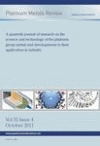-
oa The Wetting of Platinum and Its Alloys By Glass
I—Contact Angle Determinations Between Glass and Pure Platinum
- Source: Platinum Metals Review, Volume 9, Issue 3, Jul 1965, p. 92 - 99
-
- 01 Jan 1965
Abstract
Most of those industrial processes involving the bulk handling of molten glass would be facilitated if the platinum surfaces employed were more resistant to wetting. No reliable information on this subject has hitherto been published, and some recent work in the Johnson Matthey Research Laboratories has demonstrated the complexity of the high temperature relationships encountered. The way in which glass reacts with pure platinum is described in the first part of this paper. Subsequent parts will show how the equilibrium contact angle increases gradually with increasing rhodium content and more rapidly with the addition of small quantities of gold. The resistance to wetting of certain of the rhodium-gold-platinum alloys will then be correlated with their microstructure and physical properties.


